Are you passionate about photography and want to start a blog to share your photos with the world? Or maybe you’re looking to make some extra cash by monetizing your blog? Either way, you’ve come to the right place!
In this guide, we’ll show you how to start a photography blog & make money online in 2026. We’ll make it easy and cover everything from choosing a niche and registering your domain name to setting up WordPress and writing your first blog post. We’ll also give you some tips on promoting your blog and monetizing it to make money.
So if you’re ready to get started, read on!

How to Start a Photography Blog in 7 Steps
- Define Your Photography Blogging Goals
- Choose a Photography Niche
- Pick & Register a Blog Domain Name
- Setup WordPress
- Write & Publish Blog Posts
- Promote Your Photography Blog
- Monetize & Make Money
1. Define Your Photography Blogging Goals
Before you start a photo blog, it’s important to define your goals. Ask yourself why you want to start a blog in the first place. Are you looking to share your photos with the world? Or are you hoping to make some money from your blog? Once you know what your goals are, you can tailor your content and strategies accordingly.
If you’re just starting out, it’s best to set realistic goals. For example, if your goal is to make money from your blog, don’t expect to start earning a full-time income from it overnight. It takes time, effort, and patience to build a successful blog. So focus on setting achievable goals that you can gradually work towards.
What is a Photography Blog?
A photography blog is a platform to write articles about photography, share tips, and advice, and even showcase & sell photos.
There are many different ways to monetize a photography blog, but it’s important to remember that it takes time and effort to build a successful blog.
Why Start a Photography Blog?
There are many reasons why people start photography blogs. For some, it’s a way to share their photos and stories with the world. For others, it’s a way to make money from their passion.
Whatever your reason for starting a blog, it’s important to have a clear goal in mind. This will help you stay focused and motivated, and ultimately make your blog a success.
The benefits of starting a photography blog include:
- Sharing your photos and stories with the world
- Connecting with other photographers and enthusiasts
- Learning more about photography
- Earning an income from your passion
How much money can you make from photography blogging?
This depends on many factors, such as the niche you’re in, the quality of your content, and how much traffic you’re able to generate. The median ad income of a blog with 100 posts is $2815 per month. Blogs monetized with affiliate marketing and digital products can make more.
The photography blog Digital Photography School makes over a million dollars every year.
2. Choose a Photography Niche
Once you know what your goals are, it’s time to choose a niche for your blog. A niche is simply a particular topic or area that you’ll focus on writing about. When it comes to photography, there are endless possibilities for niches. You could write about landscape photography, travel, or food photography.
Why choose a niche?
There are several reasons why it’s important to choose a niche for your blog:
- It allows you to focus your content and become an expert in that area.
- It helps you attract a specific audience who are interested in that topic.
- It makes it easier to monetize your blog because you can target advertising and products to your niche audience.
Finding Your Ideal Niche
If you’re not sure what niche to choose, think about what topics you’re passionate about or what kind of photography you enjoy most. You could also try brainstorming a list of possible niches and then narrowing it down to the one that you’re most interested in.
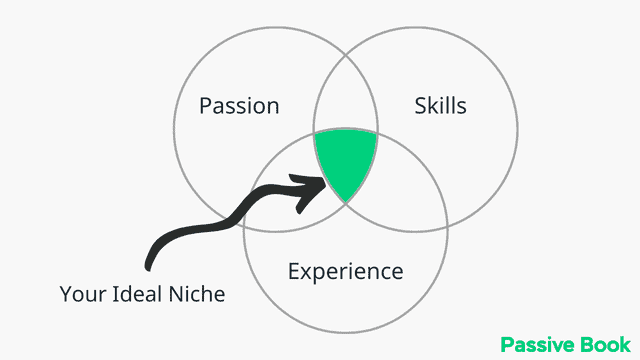
Some photography niches include:
- Travel Photography
- Food Photography
- Portrait Photography
- Wedding Photography
- Landscape Photography
- Sports Photography
- Wildlife Photography
- Photography Blog for Photographers
Examples of Photography Blog
Sometimes looking at other photography blogs will help inspire ideas of your own. Here are some of the more popular photography blogs:
[auto-list-number] Improve Photography
This is a blog by Jim Harmer. The blog covers photography tips, buying guides, gear recommendations, marketing, and business aspects for photographers. The blog makes money through ads and affiliate marketing.

[auto-list-number] Two Loves Studio
This is a blog by Rachel Brenke that focuses on Food Photography. The blog covers topics such as business tips, legal advice, social media marketing, and blogging resources for photographers. The blog monetizes with affiliate marketing and digital products.

[auto-list-number] PetaPixel
This is a blog about digital photography. The blog includes photography news, reviews, guides, and tutorials.

[auto-list-number] Women Photograph
This blog focuses on women photographers and nonbinary visual journalists. The blog includes interviews, tips, and equipment recommendations.

[auto-list-number] Click It Up a Notch
This is a blog by Courtney Slazinik that focuses on photography tips, tutorials, and resources. The blog has a store where they sell ebooks, presets, and Lightroom brushes.

3. Pick & Register a Blog Domain Name
Once you have chosen your niche, it is time to brainstorm a few names for your photography blog.
We recommend you keep your blog’s name to two words (Example: Peta Pixel). One of the two words should be a keyword from your niche. The other word can be something that makes your website brandable. For example, our blog teaches people how to make passive income, so we have named it Passive Book.
Here are some of the words that you can mix and match into your blog name:
- Photography
- Shoot
- Pixel
- Lens
- DSLR
- Photo
- SLR
- Shutter
- Focus
- Studio
Use a Business Name Generator to brainstorm the name of your blog.
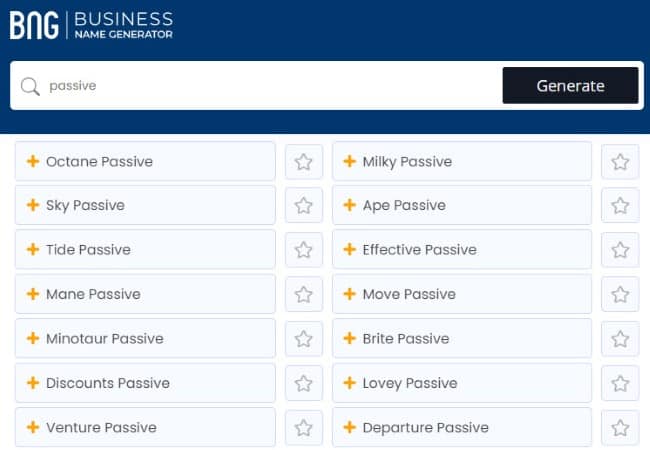
You can also use your own name for your blog. But if you ever plan to sell your website in the future, it is much more difficult to transfer your brand to the buyer when it is your name.
Check Domain Name Availability
After you have brainstormed a few names for your photography blog, you should check if the .com domain name is available.
Your domain name is your blog’s address on the internet. It’s what people will type into their browsers to find your blog. For example, the domain name of this blog is passivebook.com.
You must check if both the .com domain name and the social media handles are available. You can use Namechk to check the availability of both your domain name and social media handles.
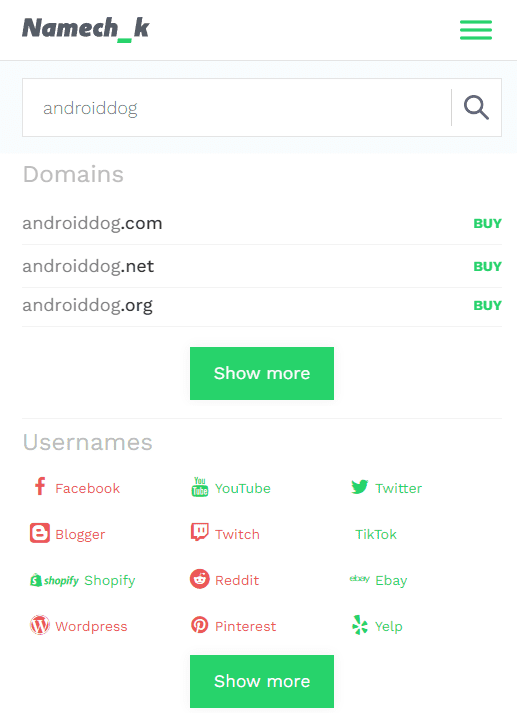
Here are a few things to keep in mind when selecting a domain name:
- Choose a .com domain name. 86% of the internet uses .com, so your visitors are likely to try visiting your blog by typing .com. Avoid other extensions like .net or .org.
- Don’t include hyphens and numbers.
- Do not use words with multiple spellings (for example colour vs color).
- Shorter domain names are better. Try to keep it under 12 characters.
- Spelling & Pronunciation should be easy and intuitive.
- It should be easy to remember.
- Avoid words that can be misread together. For example, therapistjohn.com can be read as Therapist John or The Rapist John.
- Make sure it’s not trademarked or copyrighted by someone else. The AI writing software Jarvis.ai had to rebrand to Jasper.ai because Marvel sued them for the Iron Man reference. Lawsuits will happen once your blog is established.
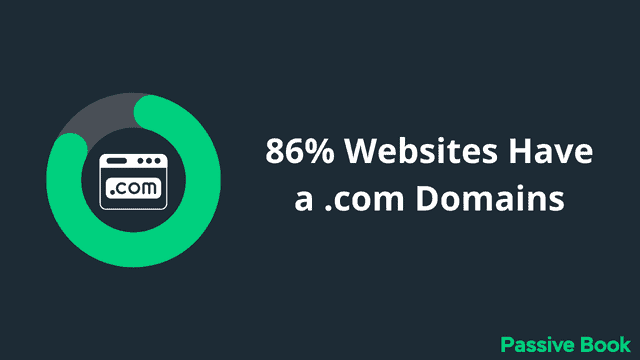
Register a Domain Name
Once you decide your domain name it is time to register it.
You should register your domain with NameCheap because you will get domain privacy for free. Other providers charge $12 per year for domain privacy. Without domain privacy, your name, home & email address will be accessible to the public.
Step 1: Go to NameCheap. Enter your domain name with the .com extension.
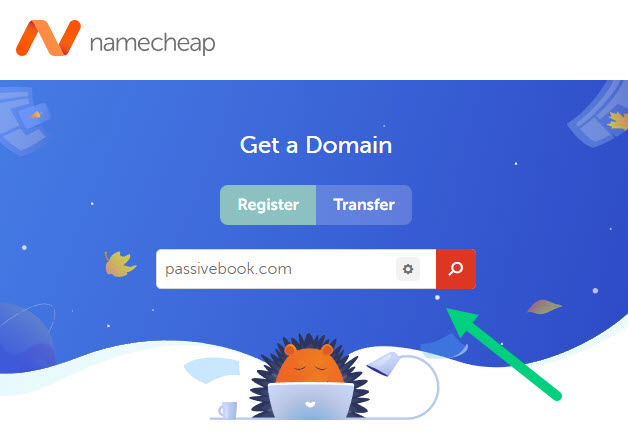
Step 2: Select the .com extension and click the Add to Cart button.
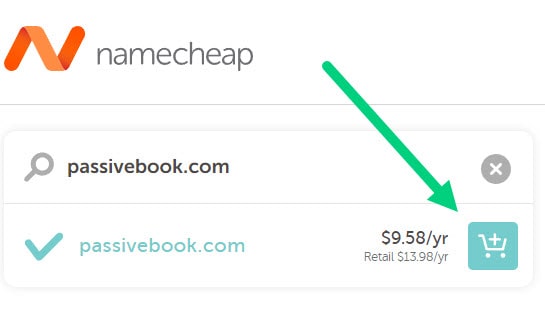
Step 3: After adding the domain to the cart, click on the Checkout button.
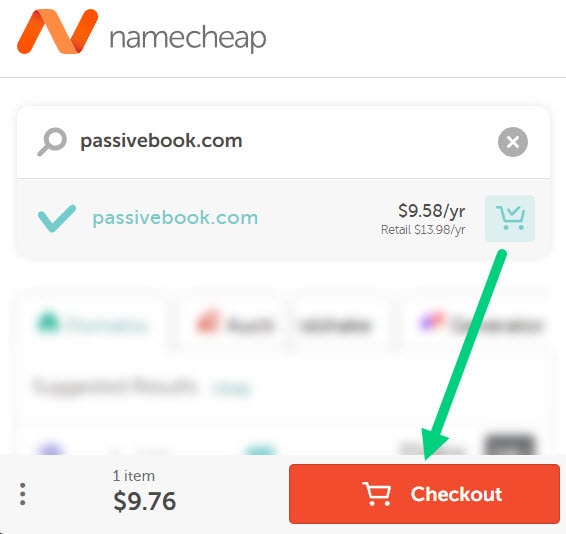
Step 4: Enable Domain Privacy that comes for free along with auto-renew. You don’t need any other paid addon.
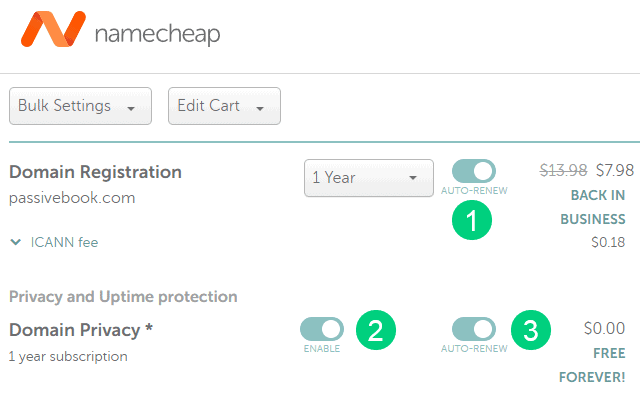
Step 5: Click on Confirm Order. Pay to complete your purchase.

Step 6: Log in to Namecheap and click on Domain List ❶ in the left sidebar and then click Manage ❷ next to the domain you just purchased.
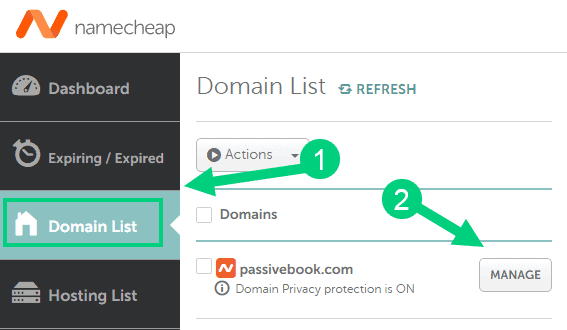
Step 7: Under the Nameservers section, select “Custom DNS” from the dropdown ❶. Then enter the following two nameservers ❷ ns1.bluehost.com and ns2.bluehost.com as shown in the image. Then click the green tick ❸ to save. If you use a hosting provider other than Bluehost, enter their nameserver values in this step instead.
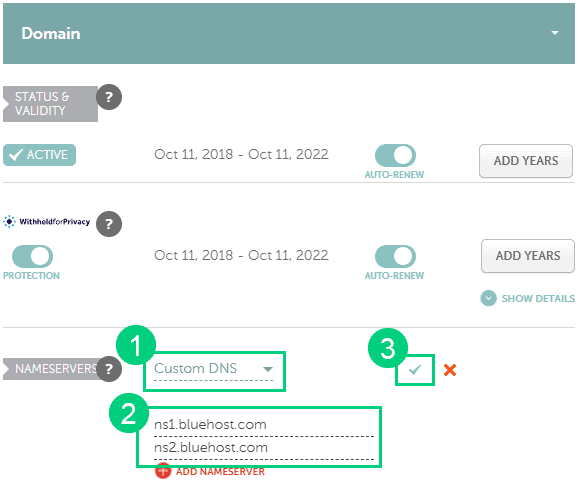
Can I get a free domain name?
Your web hosting provider might give you a free domain name for one year but they charge $12 for domain privacy which is free in Namecheap. From the second year, you will pay for both the domain and privacy which will cost you more than $20+. So it is cheaper to just register your domain with Namecheap from the beginning. Also using different companies for web hosting and domain registration will allow you to easily switch your blog host later without transferring domains.
Can I change the name of my blog later?
You will lose your search engine rankings if you change your blog’s name once it gets links from other websites. It will take as long as a year or more for you to regain the lost traffic. It is possible to mitigate problems by having proper redirects. But you will have to renew both your old and new domains every year. So try to avoid changing your blog’s name once it is established.
4. Setup WordPress
Now that you have registered your domain name, it’s time to set up WordPress. WordPress is the most popular blog publishing platform and powers most websites on the internet.
Why Choose WordPress.org?
There are many blogging platforms but the self-hosted wordpress.org powers 70% of blogs on the internet. 42% of all websites on the internet use WordPress.

The main reasons people use WordPress are:
- It’s free and open source.
- It’s easy to use. You can create a blog in minutes without any technical knowledge.
- It’s flexible. You can install themes and plugins to customize your website according to your needs.
- It’s scalable. You can start with a simple blog and later turn it into an eCommerce store, or a membership site.
- It’s secure. WordPress is regularly updated with security patches.
WordPress.org vs WordPress.com
There are two versions of WordPress – WordPress.org and WordPress.com.
Here are the main differences between WordPress.org and WordPress.com:
- WordPress.org is more flexible as you can install themes and plugins while with WordPress.com, you are limited to the themes and plugins they provide.
- With WordPress.org, you are in control of your data while with WordPress.com, they own your data. Since they own your data, they will show ads on your website but won’t pay you for it.
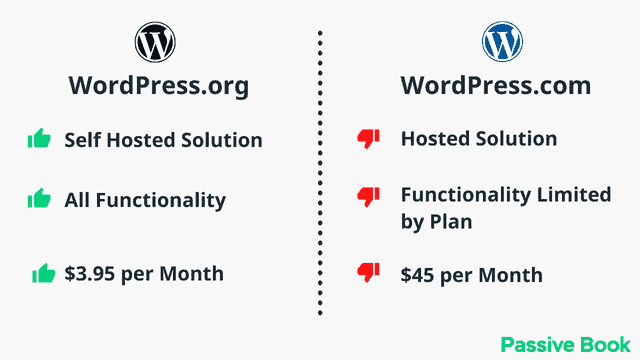
For photography blogs, we recommend using self-hosted WordPress.org as it gives you more control over your blog.
Why Avoid Free Blogging Platforms
While there are many blogging platforms, we recommend avoiding them as they have many limitations. For example, you will be limited in terms of design and customization. It is difficult to drive traffic to your website and monetize it. Moreover, they can delete your blog without any notice if they don’t like what you are writing about.

How much does it cost to start a Photography blog?
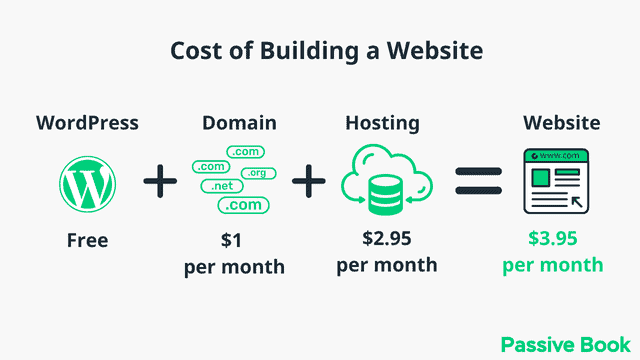
It will cost you $2.95 per month to host your WordPress photography blog in Bluehost. A domain will cost you $12/year. So that is a total of $4.2 per month, which is less than the price of Netflix for all the unlimited features that a self-hosted WordPress blog has to offer.
What to do if you already have a free blog?
If you already have a blog on a free platform like Blogger, then you can migrate your blog to WordPress with a single click using import plugins.
Install WordPress in Hosting
You need to sign up for a hosting account and install WordPress yourself.
Hosting is where your blog files are stored on the internet so people can view them in their browsers. You need to pay for hosting but it’s very affordable.
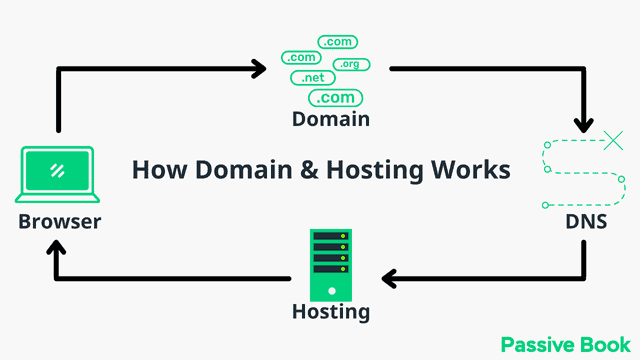
For this guide, we will use BlueHost as our web host. It is a cheap hosting that is extremely easy for beginners to set up. If you use any other web host, the steps will be the same but the user interface may be slightly different.
1. Go to BlueHost using this link to get a special discount. Select WordPress > WordPress Hosting from the top menu.
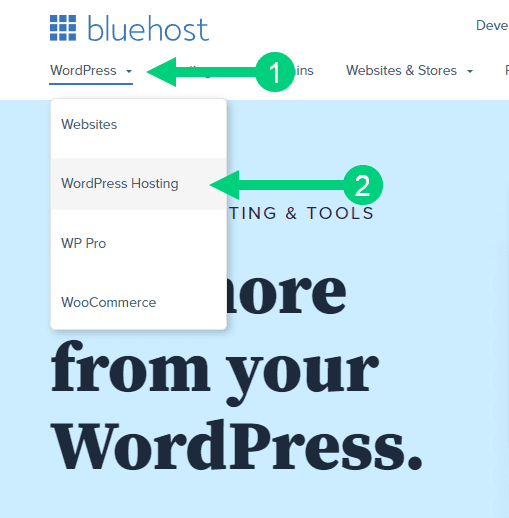
2. Click on the button you see on this page and you will be taken to the pricing section.
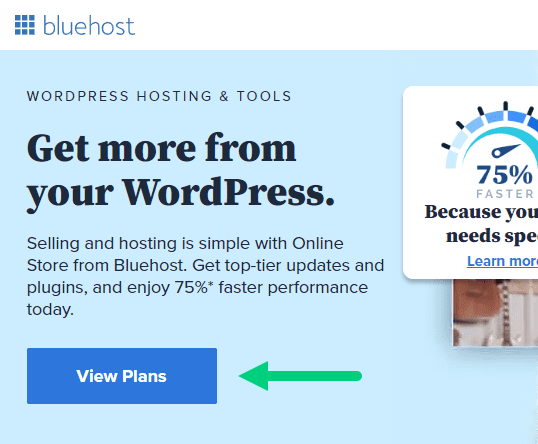
3. Select the Basic Plan. You can upgrade to a different hosting plan as you grow.

4. If you already have a domain name that you purchased with Namecheap you can put that in the “Use a domain you own” ❶ section. If you don’t have a domain name yet, choose the “Create a New Domain” ❷ to purchase a new domain.
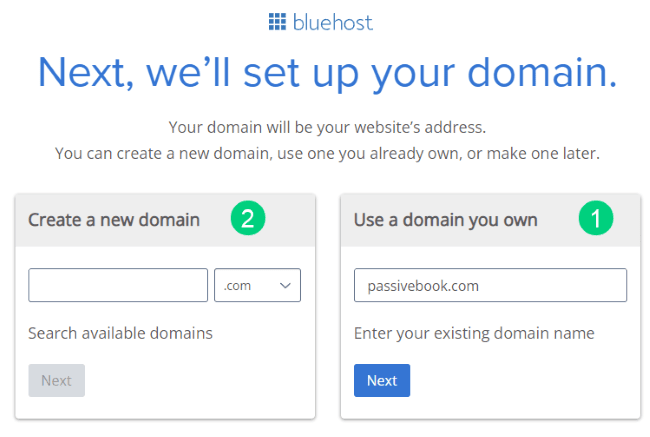
5. In the next screen, enter your information. Uncheck all package extras. If you purchase your domain through Bluehost instead of Namecheap, you may want to enable Domain Privacy. You won’t see the Domain Privacy option if you bought your domain through Namecheap. Namecheap will give you this Domain Privacy for free.
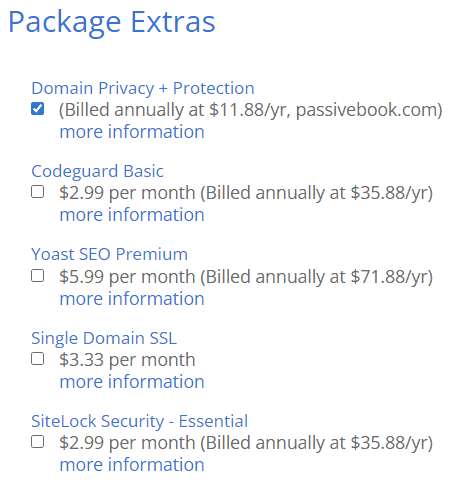
6. Once you have successfully paid, you will be prompted to set a password. Click on the “Create your Password” button.
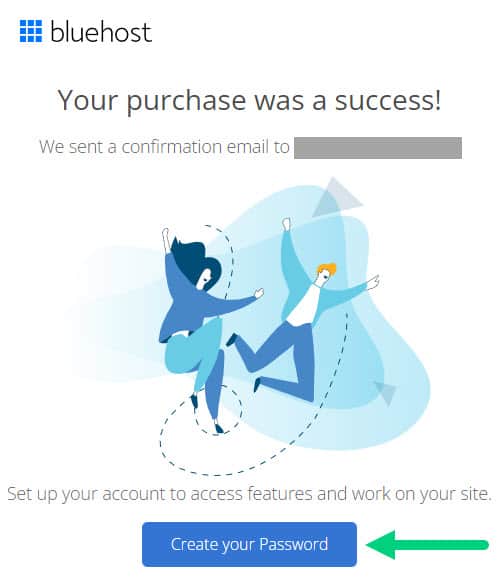
7. Enter your password and create your account. If you lose this password, you can reset it.
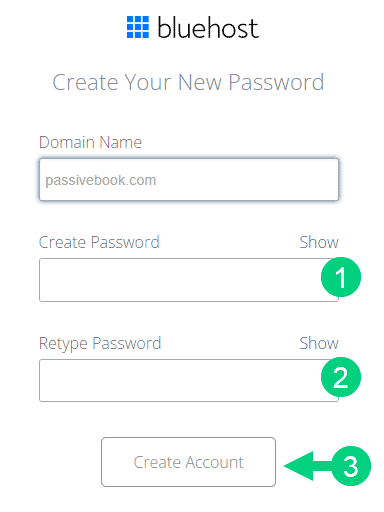
8. After you set your password, log in to Bluehost.
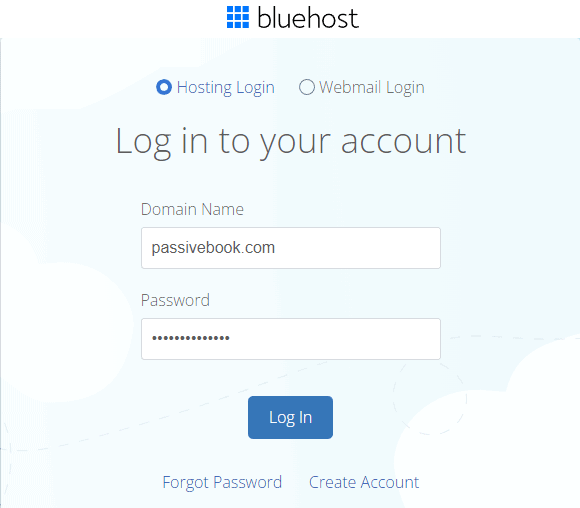
9. Click on the Create your website button on the following screen. This will start a Bluehost Wizard, just click Skip this step wherever possible.

10. On the following page, click “No help needed” or “Skip this step”. We don’t want Bluehost to limit our customization options.
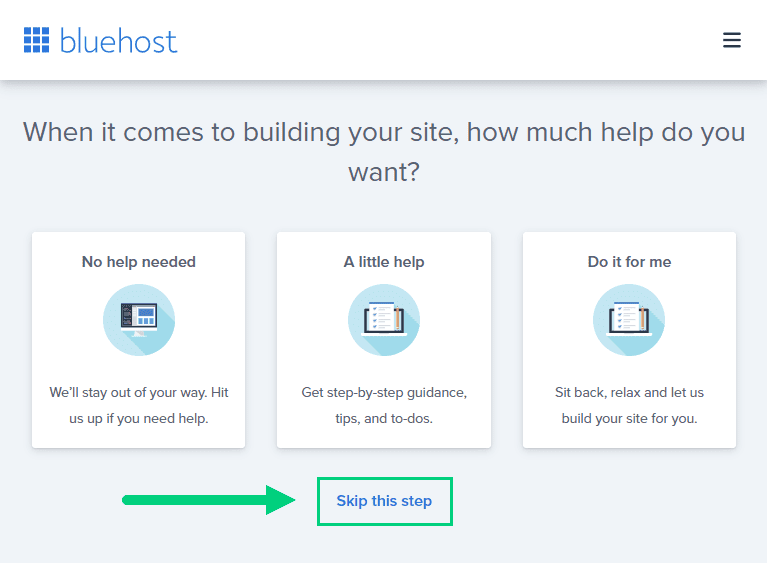
11. On the next page, you will be asked about the purpose of your website. You can choose from any of the available options.
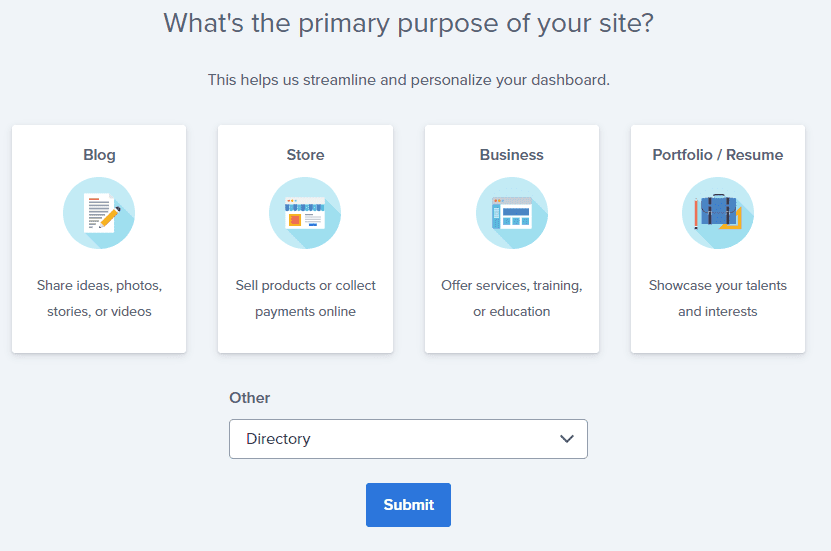
12. On the next page, click Skip this step.
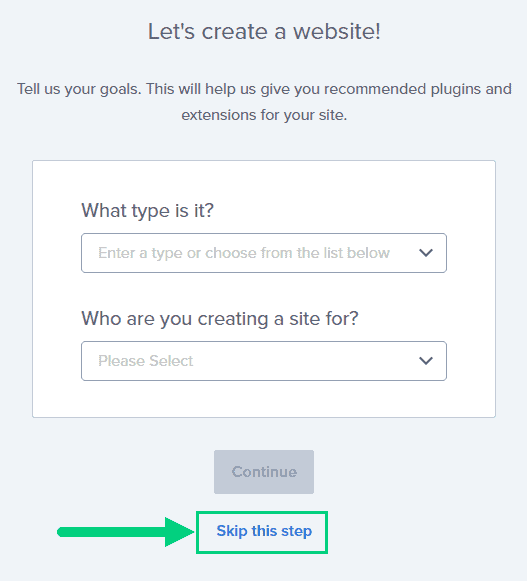
13. On the following page, enter the blog’s name and tagline. You can change this later so feel free to click “Skip this step” or enter something as a placeholder and click Continue.
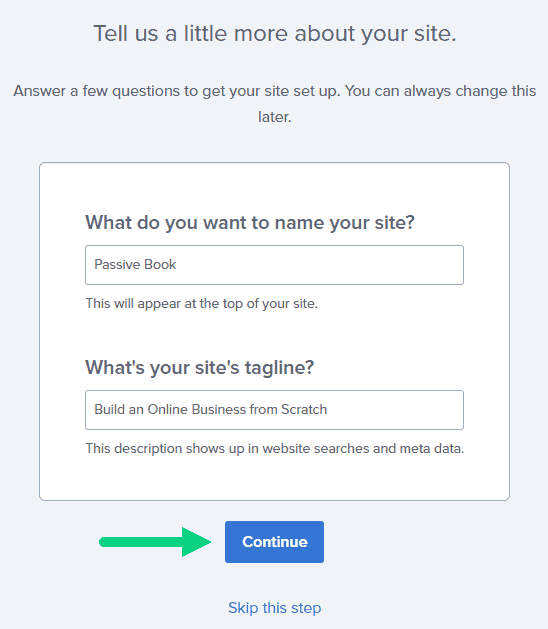
14. Finally you will be asked how you want to build your website. Choose “Limitless customization” to have all the options.

15. You can see your blog by going to yourdomain.com. Go to the Bluehost dashboard and click on the My Sites tab ❶ in the left sidebar and click on the “Manage site” button ❷.
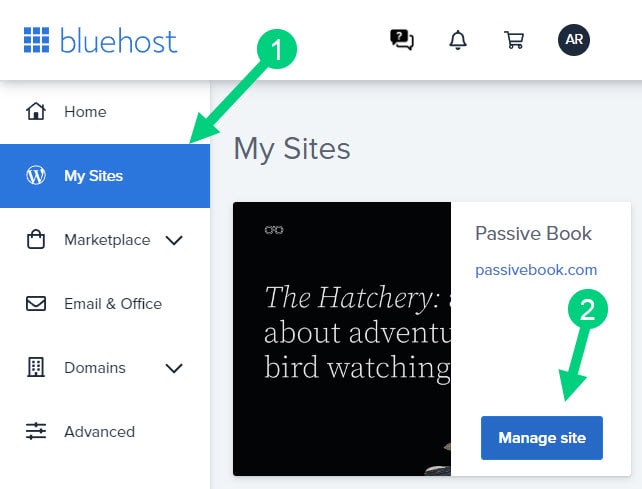
16. Your WordPress site has separate login credentials different from the ones you use to log into Bluehost. You can use this to log in to the WordPress dashboard directly without logging into Bluehost. To get this:
❶ Click on Users on top.
❷ You will be able to see your username and email that you can use to log in to WordPress.
❸ If you click on the three dots you will see the option to Reset your password. ❹
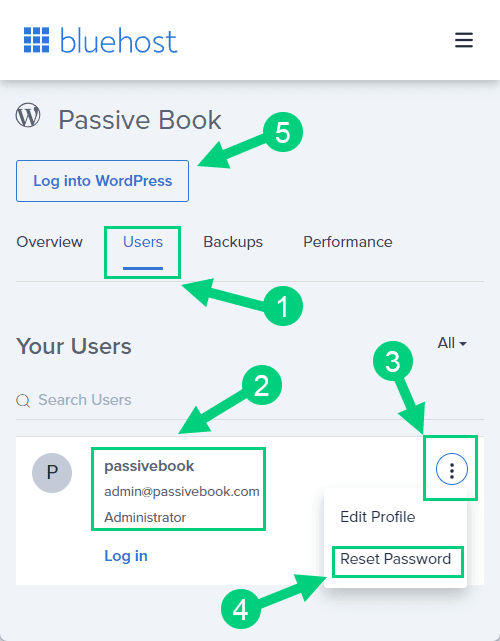
You can log into WordPress from the Bluehost dashboard by clicking the Log in to WordPress button ❺. But it is not recommended you rely on this as your primary login method because you will get locked out of your site if you ever change hosting providers.
17. You will be taken to the WordPress dashboard where you can reset your password ❶. If you don’t like the username Bluehost created for you, you can Add a New User ❷.

18. If you are adding a new user make sure you specify the user role as Administrator ❶. You can log in as the new user and safely delete the default user created by Bluehost.
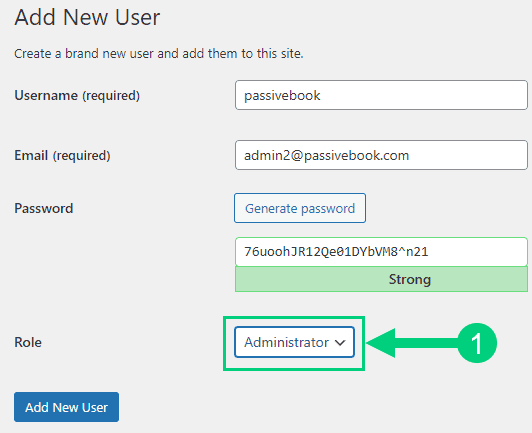
Congratulations! You have successfully set up WordPress.
Configure WordPress
Now that you have the basic version of WordPress installed, it is time to customize it to make it look and feel the way you want.
Login to WordPress Dashboard
Visit yourdomain.com/wp-admin to access the WordPress dashboard.
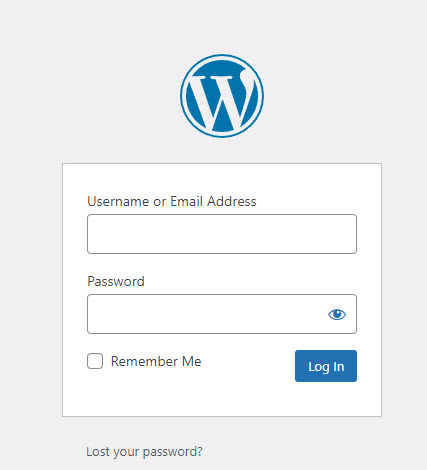
The WordPress Dashboard is the administrative area of your website where you can control all aspects of your website. You can add new posts, pages, and images; change the appearance of your website; add users and manage their permissions; and much more.
Use the Email and Password you provided during installation to log in to your WordPress dashboard. If you don’t have a password, use the “Lost your password?” to generate a new password.
Install WP Themes
A WordPress Theme is a collection of files that control the appearance and functionality of your website. When you install WordPress, you will also install a default theme. However, it is recommended that you install a custom theme that better suits your needs.
There are thousands of free and premium WordPress themes available for download. You can search for themes on the WordPress.org website or third-party websites.
The default WordPress blog theme won’t look very great.
To install a new WordPress Theme:
Go to Appearance > Themes > Add New in your WordPress dashboard.
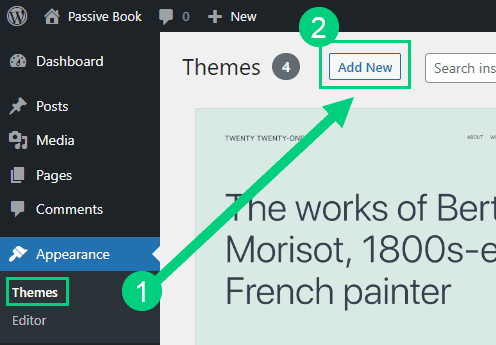
Use the search to find a theme that you like ❶. Before you install the theme, you can see a demo of the theme and learn about its features from the preview screen ❷. If you like the theme, you can install it by clicking the install button ❸. You can also upload a theme from a file on your computer ❹.
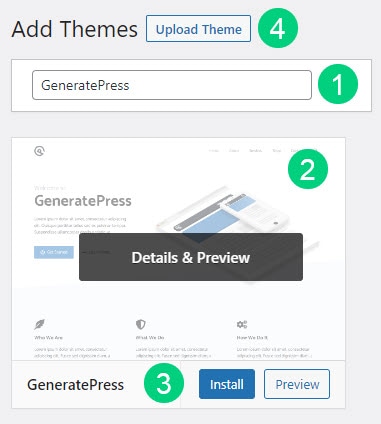
Once installed, click the Activate button to enable the theme.
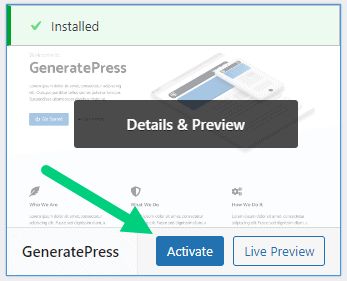
Although you can use a free theme (there are thousands of free themes available), we recommend using a premium theme.
Premium themes not only reduce your website’s load time but also help you customize your website to your heart’s desire.
Here are the premium themes we recommend:
There are also several themes custom-made for photography blogs. These themes tend to be bloated with poor code which will slow down the performance of your website. We suggest getting one of our recommended themes for a fast website with unlimited customization possibilities.
Install WP Plugins
A WordPress Plugin is a software that adds additional features and functionality to WordPress. There are thousands of plugins available for free on the WordPress.org website, and thousands more available for purchase from third-party websites.
There are plugins to do everything from adding social media buttons to your website to creating a custom post type for your photography blog.
Too many wordpress plugins can slow down your blog site. So before you install new plugins, it will be worth clearing out any existing plugins that your hosting provider installed by default.
Plugins first need to be deactivated before they can be deleted.
❶ Go to WP Admin > Plugins > Installed Plugins
❷ Click on the checkbox to select all plugins.
❸ Select Deactivate from the drop-down.
❹ Click Apply.
❺ Repeat the above steps but select “Delete” instead of “Deactivate” from the dropdown in ❸ to delete all the deactivated plugins.
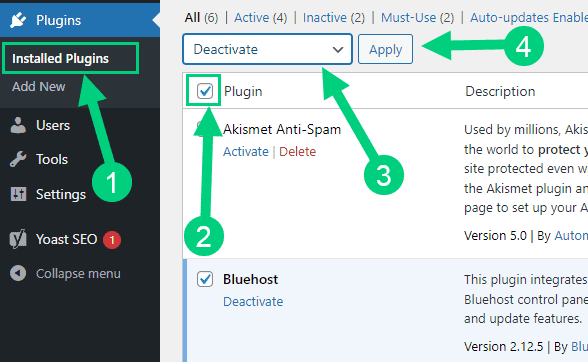
To install new plugins go to the WP Admin > Plugins > Add New.
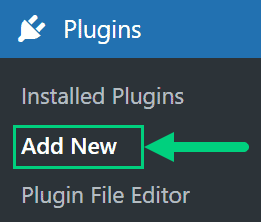
On the plugins page:
❶ Search for the plugin you want in the search bar
❷ Click Install Now. Once you install the plugin, you must also activate the plugin for it to be enabled.
❸ If you are installing a paid plugin you can upload the plugin instead.
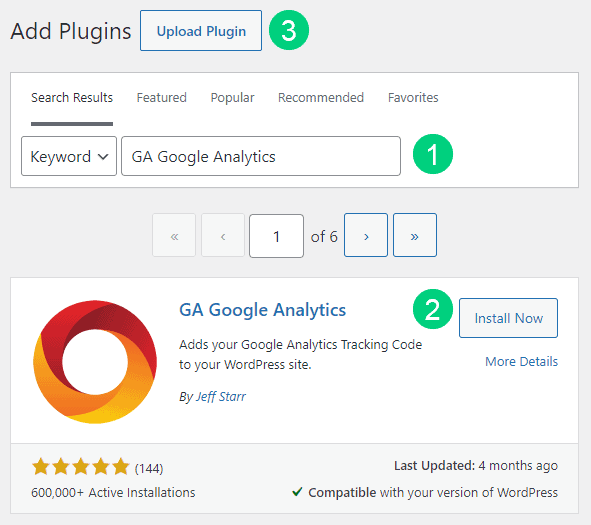
There are many different plugins that you can install, but here are the ones which we recommend:
Backup Plugin: A WordPress Backup Plugin creates backups of your website so you can restore it if something goes wrong.
Recommended Plugin: WPVivid (paid) or UpdraftPlus (free).
SEO Plugin: A WordPress SEO Plugin helps you improve the visibility and ranking of your website in search engines.
Recommended Plugin: RankMath (paid).
Google Analytics Plugin: A WordPress Google Analytics Plugin helps you collect and track data about your website visitors. This data can then be used to improve your blog’s performance.
Recommended Plugin: RankMath (paid) or GA Google Analytics (free).
Cache Plugin: A WordPress Cache Plugin speeds up the loading of your website by caching static files like images and JavaScript. This means that instead of having to download these files every time someone visits your website, the files are stored on the server and served to visitors quickly and efficiently.
Recommended Plugin: WP Rocket (paid).
Page Builder Plugin: A WordPress Page Builder Plugin helps you create custom pages and posts for your website. With a page builder plugin, you can easily create custom layouts for your pages and posts, without having to edit any code.
Recommended Plugin: Thrive Architect (paid).
Security Plugin: A WordPress Security Plugin helps you protect your website from hackers and malware. Some of the features a security plugin might have include password protection, two-factor authentication, malware scanning, and firewall protection.
Recommended Plugin: Wordfence (free).
Social Media Plugin: A WordPress Social Share Plugin is a software that helps you share your blog posts on social media platforms like Facebook, Twitter, and LinkedIn.
Recommended Plugin: Easy Social Share Buttons (paid).
Image Compression Plugin: A WordPress Image Compression Plugin is a software that helps you compress the images on your website to make them smaller in size. This can help improve the loading time of your website.
Recommended Plugin: ShortPixel (paid).
Gallery Plugins: A WordPress Gallery Plugin is a software that helps you create beautiful image galleries for your website.
Recommended Plugin: Envira Gallery (paid).
Portfolio Plugins: A WordPress Portfolio Plugin is a software that helps you showcase your photography work on your website.
Recommended Plugin: Envira Gallery (paid).
Image Slider Plugins: A WordPress Image Slider Plugin is a software that helps you create image slideshows for your website.
Recommended Plugin: Meta Slider (free).
Watermark Plugins: A WordPress Watermark Plugin is a software that helps you add watermarks to your images. This can help protect your images from being stolen.
Recommended Plugin: Image Watermark (free).
Customize WordPress
Once you have installed your theme and plugins, it is time to customize the wordpress blog platform:
Change Colors, Fonts & Spacing
You can set the font, colors, and spacing by going to Appearance > Customize in your WordPress dashboard. Premium themes like GeneratePress allow you to customize every aspect of your blog.

Check out our Blog Fonts & Typography guide to choose the right font and typography settings for your blog.
Add Your Logo
Get a logo designed for your blog from Fiverr. Then set the logo of your blog by going to Appearance > Customize in your WordPress dashboard. A logo is not required for a successful blog but it can definitely help appeal to your target audience.
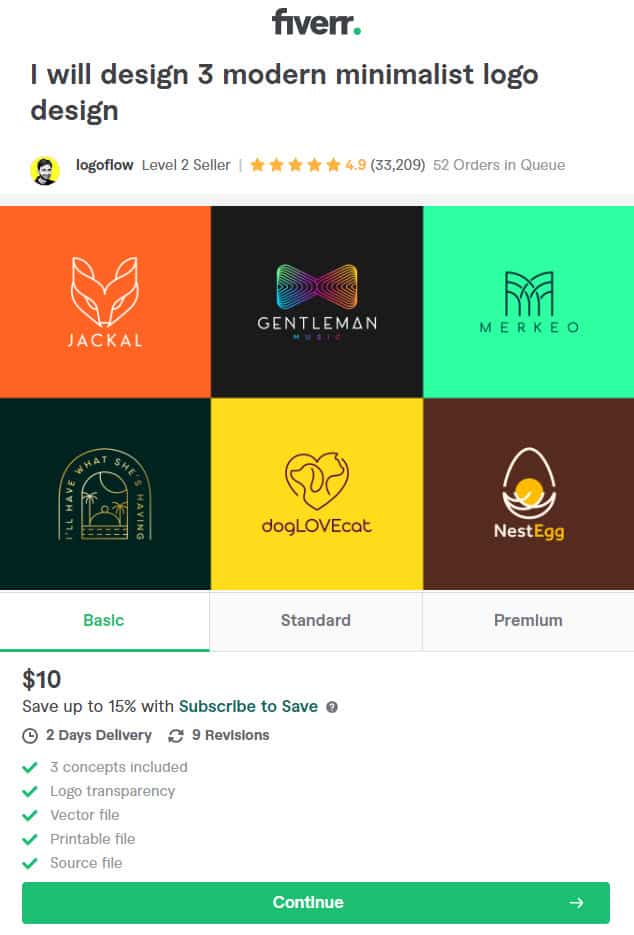
Change Favicon
Favicon is the image that appears in the browser tab and bookmarks. Set the Favicon from the Appearance > Customize section of the WordPress dashboard.

Create Menus
The header and the footer menu can be set from the Appearance > Menus in your WordPress blog dashboard.
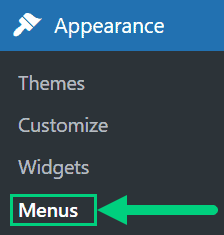
You can nest menu items so that it appears as a dropdown menu ❶. You can use the menu as your primary or secondary navigation menu ❷. Don’t forget to save your menu ❸.
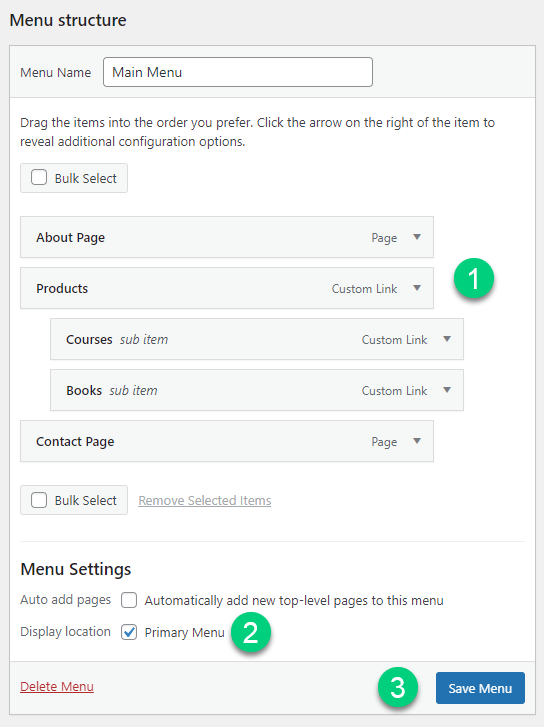
Create Widgets
If you have a sidebar, you can add widgets to it. Go to Appearance > Widgets in your WordPress admin dashboard.
Check out the list of the most useful Blog Widgets and how to add them to your blog.

Set Title & Tag Line
The next step is to change your General Settings. Go to Settings > General in the WordPress Admin area.
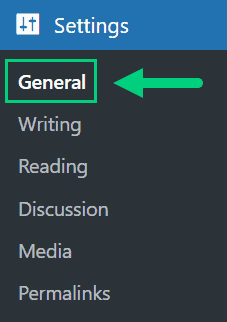
You can set your Site Title, Tagline, and Time Zone from this screen.
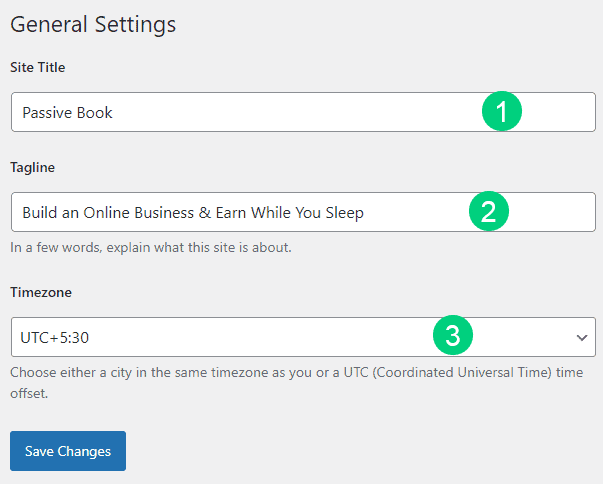
Set Permalinks
The ideal URL structure for SEO is yourdomain.com/sample-post. Set your permalink structure by going to Settings > Permalinks in your WordPress blog dashboard.

Select the “Post name” radio button and save changes.
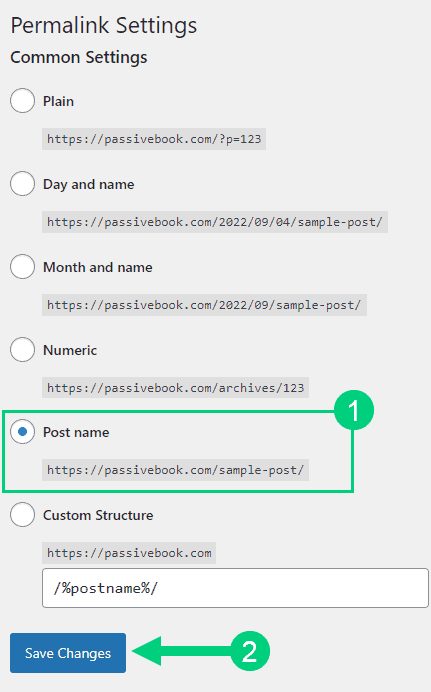
Enable Search Visibility
Chances are you want your blog to show up on Google so people can find you. Go to Settings > Reading in your WordPress dashboard.
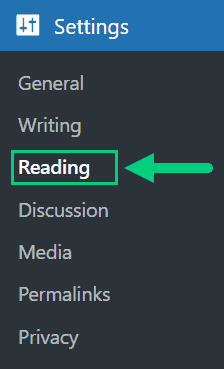
To get search engine traffic, ensure the checkbox “Disable search engines from indexing this site” is Unchecked. You can find this option in Settings > Reading. Most of the time this should be unchecked by default but if it is not, then uncheck it to ensure your site gets traffic from search engines.
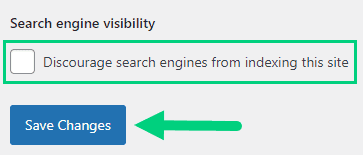
Adjust Comment Settings
Next, you will want to change the Discussion Setting (aka Comments). Go to Settings > Discussion in your WordPress admin area.
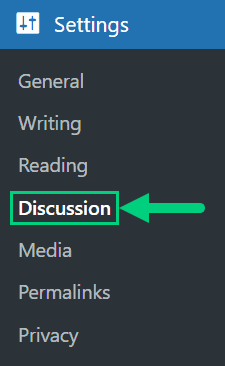
❶ You may want to enable or disable comments on this page. You can also disable pingbacks and enable comment moderation.
❷ You can also set comment approval settings.
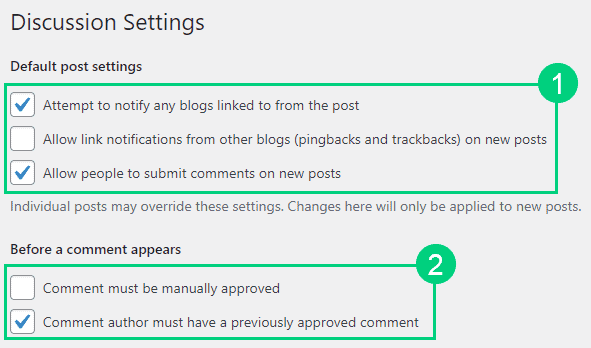
If you want to design your blog further, check out our dedicated guide on blog design which has all our best blog design recommendations.
Create Static Pages
There are a few essential pages that you need to create for your photography blog before you can start blogging.
Use pages in WordPress to add static content. Go to WP Dashboard > Pages > Add New.
- Write the headline of your content.
- Populate the body content
- Click the publish button.
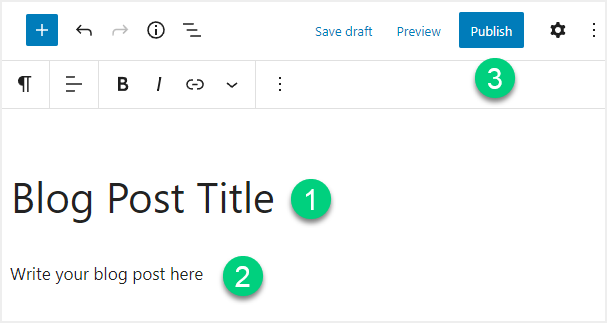
You may want to create the following pages:
Home Page
A home page is the main page of your website. It is the first page that visitors see when they visit your website. The home page typically contains a Welcome message, along with a list of your latest blog posts and/or photos.

You can create a professional home page for your photography blog using a page builder like Thrive Architect.
About Page
An about page is a page that tells visitors who you are, what you do, and why they should care. An about page typically contains information about the author, as well as links to the author’s social media profiles.
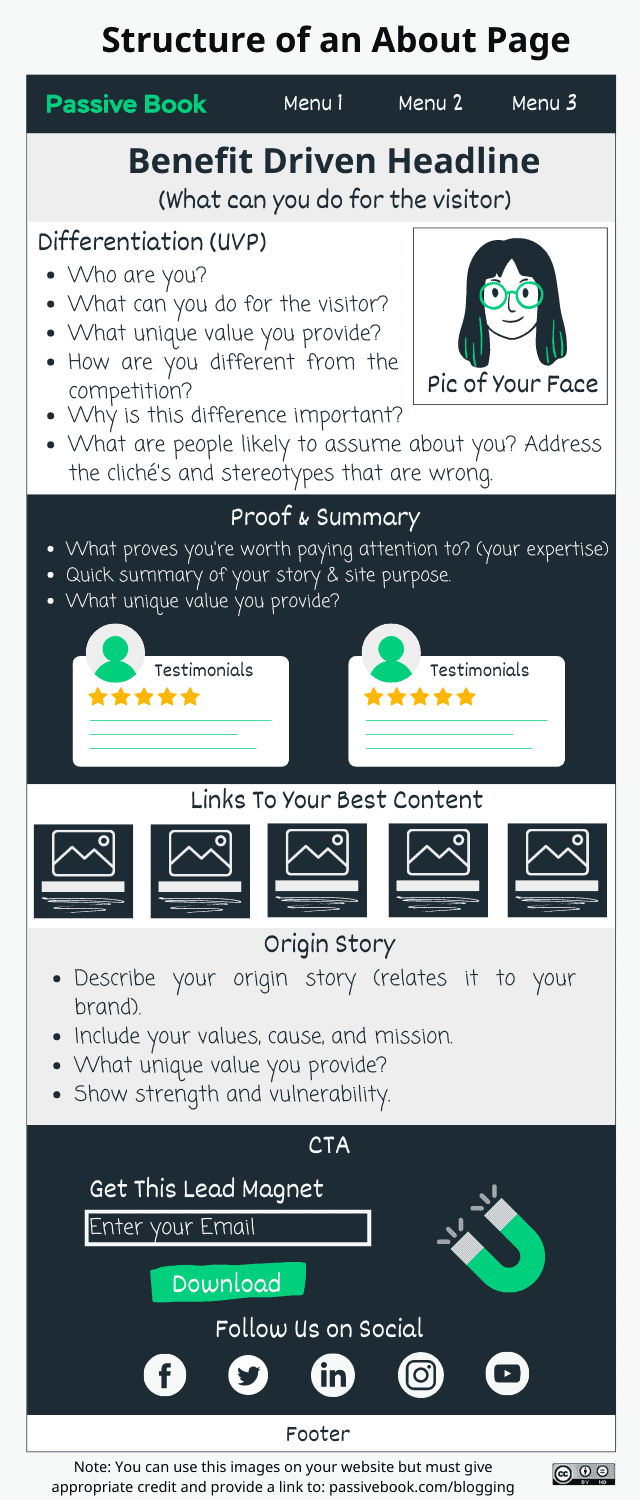
Contact Page
A contact page is a page that allows visitors to get in touch with you. A contact page typically contains a contact form, as well as your email address and social media links.
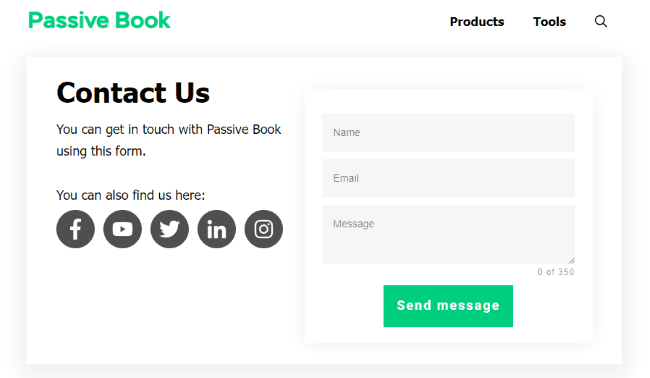
Use contact form plugins like Fluent Forms to create the form on your contact page.
Privacy Policy
A privacy policy page is a page that tells visitors how you collect, use, and protect their personal information. If you plan on collecting any personal information from visitors (such as email addresses), you need to have a privacy policy page.
WordPress generates its privacy policy for you. But you can also use a tool like Termly to generate your privacy policy.

Terms of Service
A terms of service page is a page that tells visitors what they can and cannot do on your website. A terms of service page typically contains information about copyright, trademarks, and other legal issues.
Use a terms & conditions generator like Termly to create it.
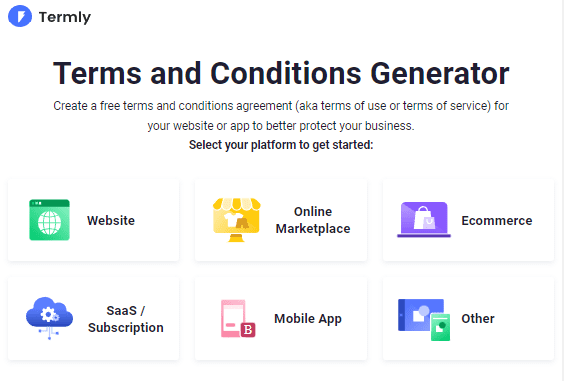
5. Write & Publish Blog Posts
Now that you have your photography blog set up, it’s time to write and publish your first blog post.
1. Brainstorm Topics
You should brainstorm 100 topic ideas for your photography blog. This will ensure that you always have content to write about in your photography blog.
The goal is to find topics for your photography blog that your audience is searching for on Google. The type of content you write on your photography blog will depend on your specific niche. You can potentially cover the following topics on your photography blog:
- Photography Tips
- Gear Reviews
- Buying Guides
- How to Guides
- Photography News
There are a few ways to brainstorm specific content:
Look at Competitors
Look at the articles other photography bloggers are writing about. Chances are, they are writing about the same topics you are. But, they may be presenting the information in a different way or from a different perspective. Steal their ideas and make them your own.
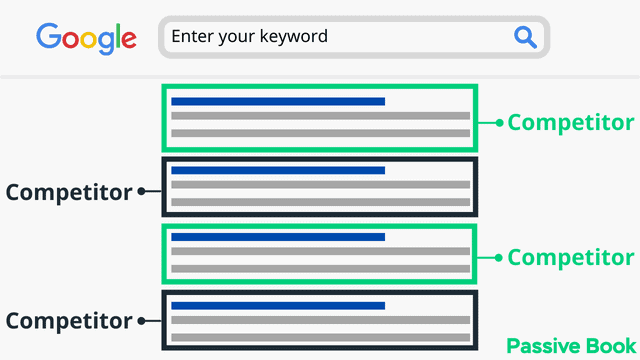
The best way to identify your competitors is to google a keyword from your niche. This will give you a list of websites that are writing about the same topic. You can then visit these websites and see what type of content they are writing.
Do Keyword Research
You can also use a keyword research tool to brainstorm topic ideas. A keyword research tool allows you to see how many people are searching for a particular keyword on Google. You can then use this information to write content that your audience is searching for.
Use free keyword research tools like KeywordTool.io or Answer The Public. Simply enter a keyword into the tool and it will show you topic ideas around that keyword.

Community & Forums
Another great way to find content ideas is to look at online communities and forums. People are always asking questions about photography on forums like Reddit. You can then answer these questions with a blog post on your photography blog. Not only will this help you generate content ideas, but it will also help you build an audience for your blog.
2. Create an Editorial Calendar
A good photography blogger is consistent. So once you have a list of content ideas, it’s time to start creating an editorial calendar. An editorial calendar is simply a document that contains all of the content you plan on writing and publishing on your blog.
Your editorial calendar should contain the following information:
- Title of Blog Post
- Publish Date
- Author
- Keyword
Download Content Calendar Template

Steal our exclusive content calendar template. Have it delivered directly to your inbox:
There are a few software and tools you can use to create an editorial calendar like Google Sheets, Microsoft Excel & Trello.
3. Write a Blog Post
Now it’s time to start writing your blog post. This is the fun part. Check out our in-depth guide on How to Write A Blog Post. Here we will go over specific tips for a photography blog.
Tutorials Posts
Tutorials are blog posts that aim to teach readers how to do something related to photography. They can be about specific techniques, camera settings, editing software, or any other aspect of photography that readers may want to learn more about.
Examples of tutorial blog post titles:
- “Mastering Manual Mode: A Step-by-Step Guide”
- “How to Edit Portraits Like a Pro”
- “The Ultimate Guide to Landscape Photography”
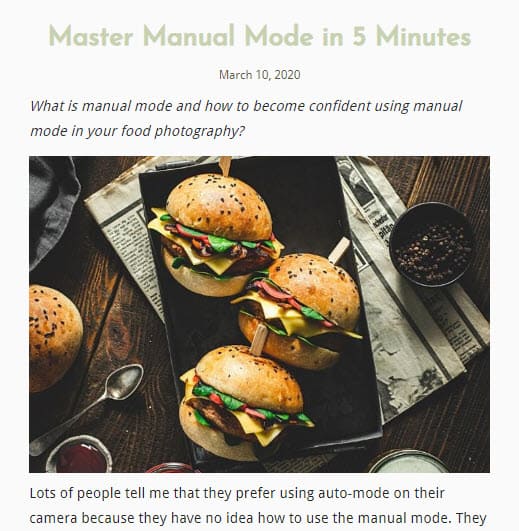
Tips for writing tutorial blog posts:
- Be clear and concise in your instructions. Use simple language and avoid jargon.
- Use images and videos to illustrate your points. This can help make your tutorial more engaging and easier to understand.
- Keep in mind the level of your audience. Tailor your tutorial to the appropriate skill level.
Photography Tips
If your blog is targeting photographers, you can write photography tips. These are tips that will help photographers improve their photography skills.
You can write a listicle-style post with 10 photography tips. Or, you can write a single, in-depth photography tip.
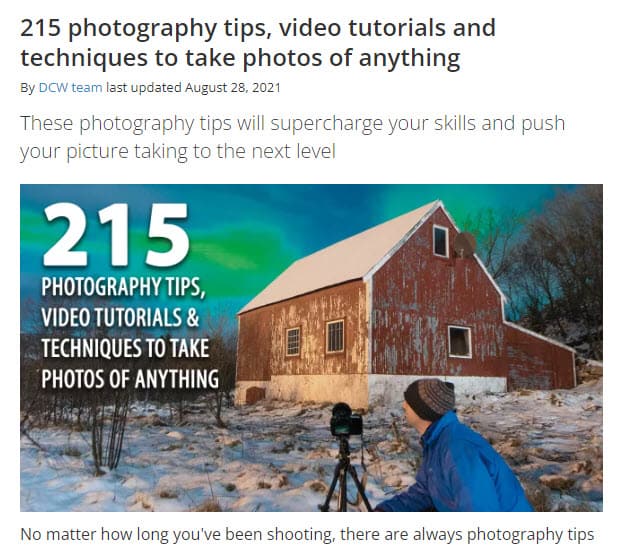
When writing your blog post, make sure to include visuals like images and videos. This will help break up the text and make your article easier to understand.
Review Posts
Reviews are blog posts that evaluate and give an opinion about a specific photography-related product. They can be about cameras, lenses, editing software, or any other product that photographers may be interested in purchasing. This is a great way to make affiliate income.
Examples of review blog post titles:
- “Canon EOS R6 Review: Is it worth the price?”
- “Adobe Lightroom vs. Capture One: Which is the best option for photographers?”
- “Nikon Z7 II Review: A Solid Camera but with a few drawbacks”

When writing your gear review, make sure to include plenty of images and videos. This will help your readers understand what the gear looks like and how it works.
You should also include a section on the pros and cons of the gear. This will help your readers understand the good and bad points of the gear.
Tips for writing review blog posts:
- Be honest and objective. Provide both the pros and cons of the product you are reviewing.
- Use images and videos to showcase the product and its features.
- Compare the product with other similar products in the market.
Inspiration Posts
Inspiration blog posts aim to provide readers with ideas for their own photography. They can be about different photography styles, locations, subjects, or any other aspect of photography that readers may find inspiring.
Examples of inspiration blog post titles:
- “5 Photographers Who Have Changed the Landscape Photography Game”
- “10 Street Photography Tips to Help You Capture the Best Moments”
- “7 Inspiring Photographers You Need to Follow on Instagram”
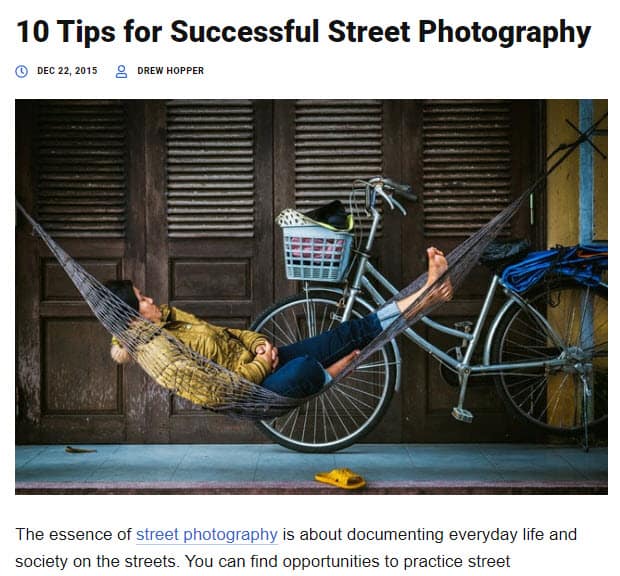
Tips for writing inspirational blog posts:
- Showcase a wide variety of photography styles and subjects. This can help cater to a wider audience.
- Use high-quality images to showcase the work of the photographers you are featuring.
- Provide links to the photographers’ websites and social media profiles so readers can learn more about them.
Buying Guides
If you want to target people who are looking to buy photography gear, you can write buying guides. Buying guide blog posts aim to help readers make informed decisions when purchasing photography-related products. They can be about cameras, lenses, editing software, or any other product that photographers may be interested in purchasing.
Examples of buying guide blog post titles:
- “The Best Cameras for Beginners: A Comprehensive Guide”
- “Lenses for Portrait Photography: What to Look for and Our Top Picks”
- “The Best Tripods for Landscape Photography: A Guide for All Budgets”
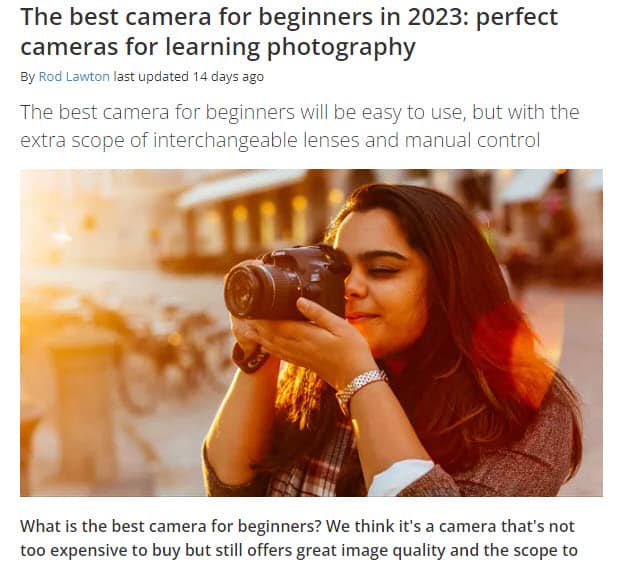
Tips for writing buying guide blog posts:
- Research the products you are going to write about thoroughly. Make sure you are familiar with their features, pros and cons, and also their price points.
- Be honest and objective in your evaluation. Provide both the pros and cons of the products you are featuring.
- Compare the products with other similar products in the market. This can help readers make a more informed decision about which product is best for them.
- Include links to where readers can purchase the products you are featuring. These links should be affiliate links so you make money if someone clicks and makes a purchase.
- Provide tips and advice on what to look for when purchasing a product of that category.
- Keep in mind the budget of your readers and include options for different budgets in your buying guides.
Photography News
News blog posts aim to keep readers up-to-date on the latest photography-related happenings. They can be about new camera releases, software updates, photography events, or any other news that photographers may be interested in.
Examples of news blog post titles:
- “The New Sony A7 IV: Everything You Need to Know”
- “Adobe Announces Major Updates to Lightroom and Photoshop”
- “The World Press Photo Awards 2021: The Winning Photos”

Tips for writing photography news blog posts:
- Stay up-to-date on the latest photography-related happenings by subscribing to photography news websites, newsletters, and social media pages.
- Provide a brief summary of the news item and include links to more information for readers who want to learn more.
- Try to provide new or unique insights on the news item, to make your post stand out from other photography news websites.
Write 5x Faster with AI
You can write your new blog post at 5x speed using the AI writing software Jasper. I was able to write over a hundred blog articles in 3 months using Jasper. This blog article you are reading right now was written with the help of Jasper. AI will not only help you write blog posts fast but also with higher quality.
Jasper can write plagiarism-free blog content, articles, social media content, emails, and ad copy. All you have to do is provide a few inputs on what you want and Jasper will do all the hard work of creating the blog content for you. No more writer’s block.
Check out the video below to see Jasper in action:
Try Jasper for free using the links on this page and get 10,000 bonus credits you can use to start writing your first articles.
Once you sign up for Jasper I recommend you spend some time going through the tutorial videos in the Jasper Bootcamp to truly unlock the power of this amazing software.
Check out our guide on How to Write a Blog Post Fast in 15 mins Without Losing Quality for more tips to write fast.
Outsource Writing
If you don’t want to write your own articles, you can always outsource the writing to someone else. There are several different sites where you can find writers, such as:

Just remember that when you outsource writing, you will need to edit the article yourself to make sure it meets your standards.
4. Add Images
Once you have written your blog post, it’s time to add images and visuals.
Images are a great way to break up the text and make your article more visually appealing. They can also help explain concepts that may be difficult to understand with text alone.
Ideally, you should take your photos with your camera if you have a photography blog.
You can also find free stock photos online. Several sites offer free stock photos, such as:
Free Options: Pixabay, Pexels, Upsplash
Paid Options: Deposit Photos, Shutterstock, iStock, Getty Images, 123rf.
Remember to only use images that you have the rights to. Do not take someone else’s photo without their permission.
You can edit your images in Canva. If you get Canva Pro then you will have access to even more editing features and a large library of stock images.

6. Promote Your Photography Blog
Now that you have written and published your blog post, it’s time to start promoting it.
There are many different ways to promote your blog post. The best way to promote your post will depend on your audience and where they hang out online.
Search Engine Optimization (SEO)
Once you have written your article, it’s time to optimize it for search engines. This is important because it will help your article rank higher in the search results.
Here are a few things you can do to optimize your article:
- Choose a keyword and use it in the title, meta description, and throughout the article.
- Make sure your article is at least 1,000 words.
- Include external links to high-quality websites.
- Internal link to other articles on your blog.
Many factors go into SEO, and it can be a bit confusing to figure out where to start. You can master the more advanced SEO tactics by checking out our SEO Resources.
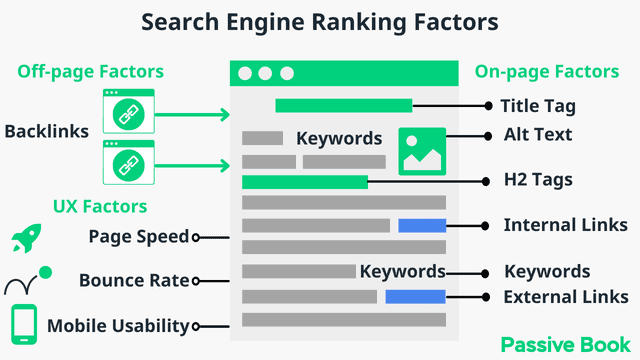
You can ensure you get the basics of SEO right, by completing the recommendations given by the RankMath plugin.
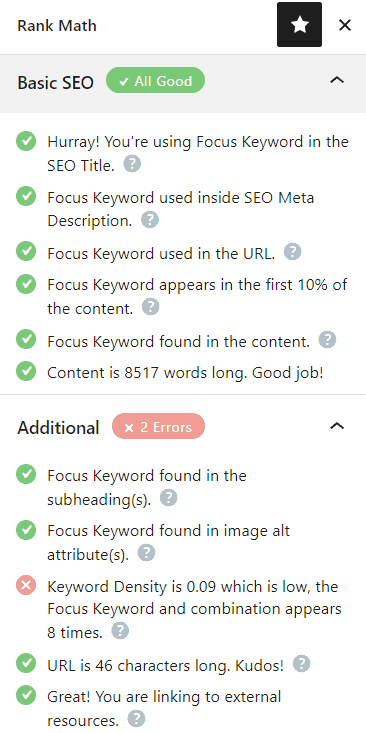
Email Marketing
Email marketing is a great way to promote your blog post to your email list.
If you don’t have an email list, you can start building one by adding an opt-in form to your website. This will allow people to sign up to receive your emails.
Once you have an email list, you can send out a weekly newsletter that includes your latest blog post.

You can also send out a special email blast whenever you publish a new article.
You can use the Thrive Leads plugin to build opt-in forms to collect email addresses. You can then connect the opt-in form to an email marketing service like Active Campaign to send out the emails.
Check out our Email Marketing resources to learn more.
Social Media Marketing
Social media is a great way to promote your blog post and reach a wider audience.
When promoting your article on social media, it’s important to use images and visuals. This will help your post stand out and get more clicks.
It’s also a good idea to post at different times throughout the day to reach a larger audience.
Guest blogging
Guest blogging is a great way to get your article in front of a new audience.
When guest blogging, you will write an article for another blog in your niche. In return, they will allow you to include a link back to your website from the guest post and author bio.

This is a great way to reach a new audience and get more traffic to your website.
To find guest blogging opportunities, you can search Google for your niche + “write for us” or “guest post”.
For example, if you have a photography blog, you can search for “photography write for us” or “photography guest post”.
7. Monetize & Make Money
After you have the traffic coming to your website, it’s time to start monetizing your blog. Here are a few common ways:
Advertising
One of the most common ways to make money from a blog is by selling advertising space. This is when you allow other businesses to place ads on your website.
In return, they will pay you a certain amount of money for each month that their ad is on your site.
To start advertising on your blog, you can sign up for an ad network like Ezoic (they pay more than Google Adsense). When your blog starts getting more than 100,000 page views a month you can monetize with Adthrive.
| Ad Network | Earnings Per 1K Impressions (EPM) | Monthly Traffic Requirement |
|---|---|---|
| Ad Thrive | $13 | 100,000 |
| Ezoic | $3 | 10,000 |
| Media.net | $1 | – |
| Google Adsense | $1 | – |
Affiliate Marketing
Affiliate marketing is when you promote other people’s products or services on your website.
If someone clicks on your affiliate link and makes a purchase, you will earn a commission.
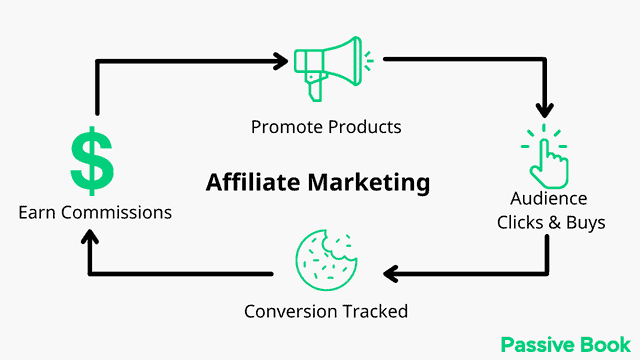
This is a great way to make money from your blog because you only make money when someone buys something.
To find affiliate programs, you can search for your niche + “affiliate program”. For example,
Sell Products
Another way to make money from your blog is by selling products. This could be anything from eBooks to online courses to physical products.
If you’re selling physical products, you will need to set up a shopping cart on your website. You can also sell digital products like courses and ebooks.
You can use Teachable if you want to sell video courses. Your students will have a dedicated course members area and a community system to ask questions and interact with each other. If you only want to sell eBooks, you can use SendOwl which lets you sell your digital products and eBooks for free.
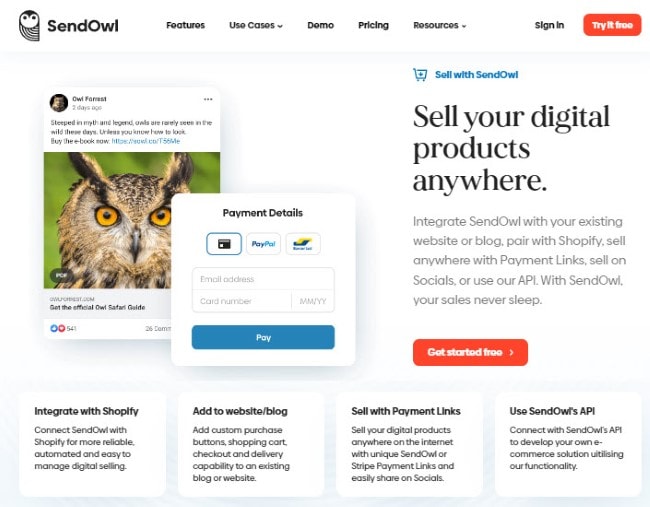
Sell Services
If you’re a professional photographer, you can sell your services on your blog.
This could include anything from family portraits to wedding photography.

To sell your services, you will need to create a portfolio on your website. This will showcase your work and help people decide if they want to hire you.
Sponsored Posts
Sponsored posts are when a company pays you to write about their product or service on your blog.
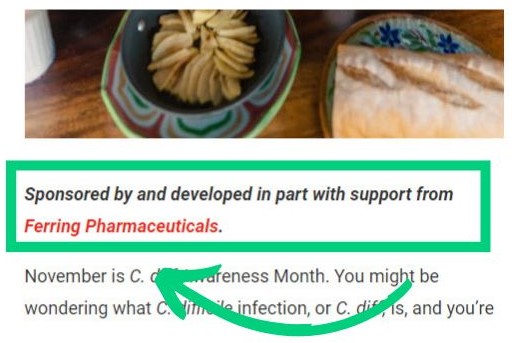
This is a great way to make money from your blog because you can get paid to write about something that you’re already interested in.
To find sponsored post opportunities, you can search for your niche + “sponsored. For example, “photography sponsored post”.
FAQ
Here are a few frequently asked questions:
What do you write in a photography blog?
When writing a photography blog, you can write about anything related to photography. This could include tips on taking better photos, reviews of cameras and lenses, or how-to articles on editing photos.
How do I create a free blog for my photography?
To start a free photography blog, you can sign up for a free blogging platform such as WordPress.com or Blogger.com. If you want to make money from your photography blog, you can also install the free WordPress software on your own web hosting account.
How do photography blogs make money?
The most common way to make money from a photography blog is by selling advertising space. You can also make money from affiliate marketing, sponsored posts, and selling products or services.
How do I get traffic to my photography blog?
There are a few different ways to get traffic to your photography blog. This includes guest blogging, social media, and search engine optimization (SEO).
How often should I post on my photography blog?
How often you post on your photography blog depends on your goals. If you want to grow your blog quickly, you should aim to post at least once a week. If you’re just trying to maintain your blog, you can post every 2-3 weeks.
Are photography blogs worth it?
Photography blogs can be worth it if you’re trying to grow your photography business or make money from your blog. If you’re just posting photos for fun, a blog might not be necessary and you can just use Instagram.
How long should a photography blog post be?
A photography blog post can be any length that you want. However, most blog posts are between 500-1000 words.
What Next?
If you have any questions as you set up your new blog, leave a comment below so we can help you out.
Starting a successful photography blog is a great way to showcase your work and make money online. By following the steps in this guide, you’ll be on your way to starting a successful blog. Remember to focus on writing quality content, promoting your blog, and finding ways to monetize your site.
Have you started your photography blog yet? What type of photography blog are you going to start? Let us know in the comments.
Share this post with your friends & followers:
